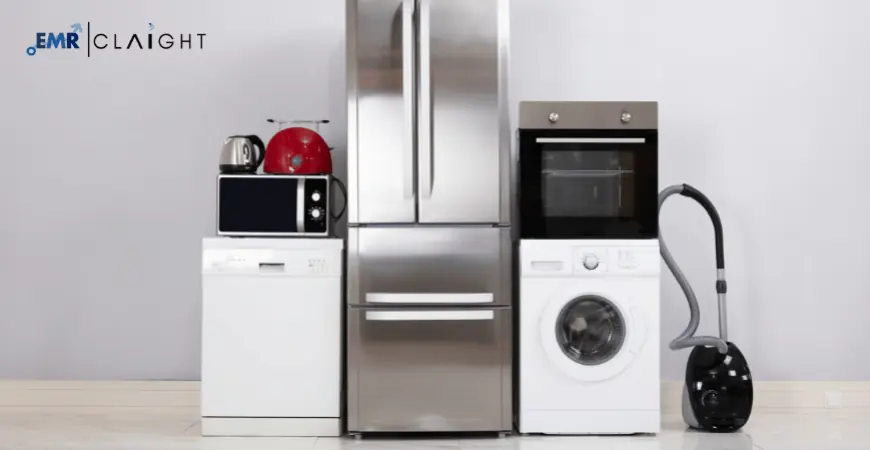Australia Kitchen Appliances Products Market Size, Trends & Forecast (2025–2034)

The Australian kitchen appliances market has been steadily growing, driven by evolving consumer preferences for more efficient, time-saving, and innovative products in the kitchen. Kitchen appliances, ranging from basic tools to advanced cooking technologies, are an integral part of daily life for Australian households. This market includes various product categories such as refrigerators, microwaves, ovens, dishwashers, coffee machines, and blenders. Technological advancements, an increasing focus on convenience, and the desire for energy-efficient solutions have further propelled the demand for kitchen appliances. With increasing disposable incomes, growing urbanization, and a shift towards modern kitchens, the Australian kitchen appliances market is expected to continue expanding at a solid pace.
Australia Kitchen Appliances Products Market Size
The Australian kitchen appliances market was valued at USD 1.56 billion in 2024, reflecting the steady demand for both traditional and modern kitchen products. This market encompasses a wide range of appliances, from basic cooking essentials to high-tech smart kitchen devices. The market's growth can be attributed to the continuous demand for convenience, time-saving products, and energy-efficient appliances. As consumers look for more sustainable and technologically advanced kitchen solutions, the market size is expected to grow significantly. By 2034, the market is projected to reach USD 2.27 billion, driven by innovation and the increased availability of smart and connected kitchen appliances.
Australia Kitchen Appliances Products Market Trends
-
Rise of Smart Kitchen Appliances: Smart technology has made a significant impact on the kitchen appliances market in Australia. Appliances like smart ovens, refrigerators, and coffee machines that connect to smartphones or voice-activated devices are increasingly popular. The ability to control and monitor appliances remotely adds convenience and energy efficiency to everyday kitchen tasks, making them highly sought after.
-
Energy Efficiency and Sustainability: With growing environmental awareness, Australian consumers are increasingly choosing energy-efficient kitchen appliances. Products with high energy ratings, low power consumption, and recyclable components are in demand. This trend towards sustainability is shaping the development of new appliances that help reduce energy usage while maintaining top performance.
-
Compact and Multi-Functional Appliances: As Australians embrace smaller living spaces, the demand for compact and multi-functional kitchen appliances has grown. Devices that can perform multiple tasks—such as a microwave that can also bake or an oven that also functions as an air fryer—are becoming popular due to their space-saving design and versatility.
-
Focus on Health and Wellness: The increasing consumer focus on health and wellness is also influencing the kitchen appliances market. Blenders, juicers, air fryers, and other products designed for healthier cooking and food preparation are in demand. These products cater to the growing trend of cooking fresh, nutritious meals at home, supporting the desire for healthier lifestyles.
Australia Kitchen Appliances Products Market Growth
The Australian kitchen appliances market is poised for consistent growth, driven by a combination of factors:
-
Increasing Consumer Demand for Convenience: As Australians seek more efficient ways to cook and prepare meals, demand for advanced kitchen appliances continues to rise. Appliances that offer ease of use, such as one-touch cooking options and programmable settings, are highly valued.
-
Technological Advancements and Innovation: The introduction of new technologies in kitchen appliances, such as AI-powered cooking modes, smart sensors, and app-controlled devices, is contributing to market growth. These innovations not only enhance convenience but also help consumers achieve better cooking results and optimize energy usage.
-
Higher Disposable Incomes and Changing Lifestyles: Rising disposable incomes and changing lifestyles are contributing to the demand for more premium, high-end kitchen appliances. Consumers are increasingly willing to invest in appliances that offer superior quality, durability, and advanced features, further driving market growth.
-
Growth in Urbanization and Small Households: With an increasing number of smaller households, particularly in urban areas, demand for compact and multifunctional kitchen appliances is on the rise. Consumers are prioritizing space-saving solutions that offer the flexibility to perform multiple tasks in a smaller area.
Australia Kitchen Appliances Products Market Segmentation
Breakup by Product Type
-
Induction Stoves
-
Water Purifiers
-
Dishwasher
-
Refrigerator and Freezers
-
Food Processors
-
Grills and Toasters
-
Mixers and Grinders
-
Range Hood
-
Microwave Ovens
-
Others
Breakup by Fuel Type
-
Cooking Gas
-
Electricity
-
Others
Breakup by Application
-
Commercial
-
Residential
-
Others
Breakup by Distribution Channel
-
Supermarkets and Hypermarkets
-
Specialty Stores
-
Online Stores
-
Others
Australia Kitchen Appliances Products Market Forecast
The Australian kitchen appliances market is projected to grow at a CAGR of 3.80% between 2025 and 2034, reaching a value of USD 2.27 billion by 2034. The market’s growth will be primarily driven by consumer demand for smart and energy-efficient appliances, as well as the rising interest in multifunctional and compact products. The increasing focus on health-conscious living and technological innovations in the industry will also contribute to the steady expansion of the market. As more consumers opt for advanced kitchen appliances to enhance their cooking experience and energy efficiency, the market is expected to continue its upward trajectory in the coming years.
Competitive Analysis
The Australian kitchen appliances market is highly competitive, with several key players leading the charge in innovation and market share. The major companies in the market include:
Samsung Electronics Australia Pty Ltd.: Samsung is a major player in the Australian kitchen appliances market, offering a wide range of high-tech and innovative products, including smart refrigerators, ovens, and dishwashers. The company is known for its cutting-edge technology and sleek, modern designs that appeal to tech-savvy consumers.
LG Electronics, Inc.: LG is a well-established brand in the Australian kitchen appliances sector, known for its high-performance, energy-efficient appliances. The company’s range of smart kitchen products, such as refrigerators and ovens with AI-powered cooking features, continues to drive its popularity in the market.
Arisit Pty. Limited: Arisit is an Australian distributor of a wide variety of kitchen appliances, including premium brands such as Beko, Fisher & Paykel, and Smeg. The company has a strong presence in the Australian market, offering both affordable and high-end solutions.
Electrolux AB: Electrolux is a global leader in home appliances, and its kitchen products are well-regarded for their reliability, efficiency, and quality. The brand has a strong foothold in the Australian market, offering everything from refrigerators to cooking appliances and dishwashers.
Panasonic Australia Pty Limited: Panasonic is known for its innovative kitchen appliances, particularly in the microwave and food preparation sectors. The company offers advanced, user-friendly appliances that cater to the needs of both everyday cooks and professional chefs.
Others: In addition to these key players, there are several smaller and emerging companies contributing to the competitive landscape in the Australian kitchen appliances market. These brands often focus on niche segments, such as sustainable appliances, budget-friendly options, or luxury kitchen solutions.
What's Your Reaction?
 Like
0
Like
0
 Dislike
0
Dislike
0
 Love
0
Love
0
 Funny
0
Funny
0
 Angry
0
Angry
0
 Sad
0
Sad
0
 Wow
0
Wow
0

















































